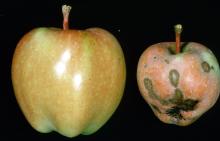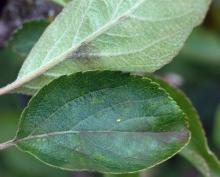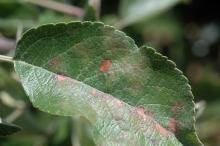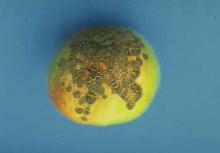See:
Cause Venturia inaequalis, a fungal disease that is common and destructive west of the Cascade Range in Oregon and Washington and coastal British Columbia. There is an average of 8 infection periods each year lasting an average of 28.5 hours (as calculated for western Oregon from 1989 to 2001). Economically important scab outbreaks can also occur in central Washington, Hood River, and eastern and southern Oregon. In these more arid districts, the disease is more of a problem when overtree irrigation is practiced.
The fungus overwinters on dead apple leaves or fruit on the ground. Infected fruit is not a source of overwintering spores. During winter, black structures (pseudothecia) develop in the dead leaf tissue. During the spring, in the presence of moisture and over a wide range of temperatures, pseudothecia produce sexual spores (ascospores), which are forcibly discharged and moved by air currents to infect young developing foliage and fruit. Infections are visible 8 to 15 days later. They in turn produce asexual spores (conidia) in 15 to 18 days whenever weather conditions are favorable. Conidia cause new infections, continuing the disease cycle.
All outer parts of unopened fruit buds are highly susceptible to infection when exposed after cluster buds break. Bud or blossom infection often leads to shedding of blossoms or to severe infection of developing fruit. Preventing infection of flower pedicel and sepals is important for successful scab management.
Mature apple fruit are much less susceptible to apple scab than immature fruit. However, infections can occur near harvest, which are not observed until apples are in storage. It can take as little as 6 hours of wetness at 70°F for infection of fruit around bloom, but it takes almost 48 hours of wetness at the same temperature to infect mature fruit.
Apple cultivars not easily grown due to scab in western Washington, Oregon, or coastal British Columbia include Red Delicious, Rome Beauty, Jonathan, Winesap, Granny Smith, Gala, Summerred, and Jersey Mac. Crabapples are also serious hosts of this fungus but hawthorn, mountain ash, and Pyracantha can also be infected.
Symptoms The first visible symptoms on leaves in spring are pale, chlorotic, water-soaked spots the size of a pinhead. These enlarge, becoming darker and smoky in appearance, later taking on an olive shade and ultimately a brownish black color. Spots may be any shape but are frequently circular. Young infections often show a radiating spread of fungal tissue just under the surface of the leaf, and such areas later appear as irregular, brown-colored infections. Spots can only be found on one side of the leaf (top or bottom) during the growing season. Diseased leaves can be curled and distorted and often drop early, thus defoliating and weakening the tree.
Scab spots on fruits are at first small, raised, brown or black circular areas with no skin breaks. Later the skin ruptures, and the exposed tissue has a brown or black velvet-like appearance surrounded by a whitish ring or torn cuticle tissue. As fruit develops, scab spots enlarge and the central areas become brown and corky, but the dark marginal zones remain. Scabs may be scattered over the fruit surface and, when numerous, coalesce into larger irregular infections. Such fruit often cracks, allowing fruit-rotting organisms into the apple.
Late-season infections may not show on fruit until they are in storage where rough, black, circular lesions develop. The lesions, usually varying in size up to 0.25 inch in diameter, are sometimes referred to as pinpoint scab or storage scab.
Cultural control
- Some apple cultivars have shown good resistance and good quality. These cultivars are Akane (Tokyo Rose), Chehalis, Liberty, Prima, and Tydeman Red. Intermediate resistance apple cultivars are Jonagold, Macoun, Melrose, Spartan, and King. Cultivars Pristine and Enterprise have both powdery mildew and scab resistance.
- Apply nitrogen (5% urea) plus an adjuvant to leaves (on or off the tree) in fall to enhance decomposition of fallen leavses and make them more palatable to earthworms. The organic equivalent would be the application of Organic Wet Betty (yucca extract) or 30% yeast extract.
- Shred fallen leaves with a flail mower to help speed decomposition of infected leaves.
- Home gardeners may reduce disease pressure by raking and disposing of fallen leaves. If put in a compost pile, be sure leaves decompose completely before spring.
- Pruning helps increase air flow and reduces the amount of time foliage is wet from rain or dew.
- Reduce irrigation sets so leaves do not stay wet for extended periods of time. Use sprinkler heads that do not wet the foliage of the tree or use drip irrigation. Irrigation for 2 hours on a sunny day prior to forecasted rainfall reduced spores during rain events and resulted in lower scab incidence in Europe.
- Apply dolomitic lime in fall, after leaf drop, to increase soil pH and to help reduce inoculum next spring.
Chemical control The key to successfully controlling scab is to apply fungicides early and thoroughly to protect new growth. The first susceptible tissues exposed in opening cluster buds are the tips of the leaves and sepals. The most critical period for scab development is from the breaking of the cluster buds until leaves are fully expanded. Apply sprays at prepink, pink, calyx, and first cover. If the disease was a problem last year, begin applications at green-tip. Forecasting also can be used to time fungicide spray especially in arid regions with few infection periods
Scab resistance to certain fungicides can occur if these materials are used exclusively or excessively. Resistance to Syllit (dodine) still persists in Quebec Canada and thus likely other places where it was overused. In one study up to 12% of the isolates were resistant to 4 different fungicide groups at the same time. To minimize the development of resistant fungi, alternate or tank-mix fungicides from different groups that have different modes of action. For example, use a tank-mix of a FRAC 3 fungicide at full rate plus a different fungicide at lower rate. Some products used in the tank-mix will also aid in bull's-eye rot control. Also, limit applications from any particular group to two (2) or fewer per year. Selection of products for rotation and/or mixing must consider FRAC 7 fungicides when used through the irrigation as a nematicide. In Pennsylvania, not using dormant copper sprays, older trees, larger orchards, orchards with ≤10 cultivars, and application of >four FRAC 3 sprays were positively correlated with the incidence of resistant apple scab isolates. Use of delayed dormant copper-based sprays reduced FRAC 3-resistant fungi in New York and should be very useful for management in the PNW.
- Aprovia at 5.5 to 7 fl oz/A plus another fungicide and an adjuvant. Do not use within 30 days of harvest. Group 7 fungicide. 12-hr reentry.
- Axios 20 SC at 2.25 to 3 fl oz/A. Do not use within 7 days of harvest. Group 52 fungicide. 4-hr reentry.
- Bonide Captan 50 WP may be used in home gardens at 1 to 1.5 Tbsp/gal water. Washington only. H
- Captan 80 WDG at 2.5 to 5 lb/A. May be applied up to the day of harvest. Do not use with oils, lime, or alkaline materials. Group M4 fungicide. 24-hr reentry.
- Cevya at 4 to 5 fl oz/A. Can be used on day of harvest. Group 3 fungicide. 12-hr reentry.
- Cinnerate at 16 to 64 fl oz/100 gal water plus an adjuvant. Can be used on day of harvest. No reentry listed. O
- Cueva at 0.5 to 1 gal/100 gal water/A. May cause russeting of some apple cultivars. May be used on day of harvest. Group M1 fungicide. 4-hr reentry. O
- Dodine FL at 1.5 pints/A plus another fungicide. Do not apply more than two (2) applications or after petal fall. Some cultivars may russet if used during bloom or freezing conditions. Group U12 fungicide. 48-hr reentry.
- Eagle 20 EW at 4 to 6 fl oz/100 gal water for home orchards or landscape use. Do not apply within 14 days of harvest. Do not use on pear. Group 3 fungicide. 24-hr reentry.
- Excalia at 3 to 4 fl oz/A plus a non-oil-based adjuvant. Do not use past petal fall. Group 7 fungicide. 12-hr reentry.
- Ferbam Granuflo at 4.6 lb/A. Do not apply within 7 days of harvest. Not recommended early season due to some cultivar sensitivity to fruit russeting and not for late season use due to black residue on fruit. Group M3 fungicide. 24-hr reentry.
- Fixed-copper products applied at delayed dormant will help manage scab fungi resistant to Group 3 fungicides. Russetting can be a problem when used during early growth stages especially under slow drying conditions. Generally 48-hr reentry depending on the product and formulation.
- Flint Extra at 2.5 to 2.9 fl oz/A. Use on a protectant schedule and not curatively. Do not use within 14 days of harvest. Injury may occur to Concord grapes if accidentally sprayed. Group 11 fungicide. 12-hr reentry.
- Fontelis at 16 to 20 fl oz/A plus another fungicide. Do not mix with thinning agents or use within 28 days of harvest. Group 7 fungicide. 12-hr reentry.
- Indar 2F at 6 to 8 fl oz/A plus a wetting agent. Do not use within 14 days of harvest. Group 3 fungicide. 12-hr reentry.
- Inspire Super at 12 fl oz/A. Do not apply within 14 days of harvest. Group 3 + 9 fungicide. 12-hr reentry.
- Kenja 400 SC at 12.5 fl oz/A plus another fungicide. Do not use within 20 days of harvest. Group 7 fungicide. 12-hr reentry.
- Luna Sensation at 4 to 5.8 fl oz/A. Do not use within 14 days of harvest. Group 7 + 11 fungicide. 12-hr reentry.
- Luna Tranquility at 11.2 to 16 fl oz/A. Do not use within 72 days of harvest. Group 7 + 9 fungicide. 12-hr reentry.
- Mancozeb (such as Dithane, Manzate, or Penncozeb) up to 6 lb/A prebloom or at 3 lb/A after bloom. Do not combine the 6 lb/A prebloom or the 3 lb/A all-season schedules. Do not apply within 77 days of harvest. See label restrictions. Group M3 fungicides. 24-hr reentry.
- Merivon at 4 to 5.5 fl oz/A. Do not use with EC or oil-based products. May be used day of harvest. Group 7 + 11 fungicide. 12-hr reentry.
- Miravis at 3.4 fl oz/A. Do not use within 30 days of harvest. Group 7 fungicide. 12-hr reentry.
- Myclotect at 4 to 6 fl oz/100 gal water plus another fungicide and spreading agent. May observe a PGR effect. Do not use within 14 days of harvest. Group 3 fungicide. 24-hr reentry.
- Omega 500 F at 10 to 13.8 fl oz/A. Do not use within 28 days of harvest. Group 29 fungicide. 12-hr reentry.
- OxiPhos at 1.3 to 5 quarts/A. Might be used to supplement a normal program. Group P7 fungicide. 4-hr reentry.
- Polyram 80 DF at up to 4.5 lb/A prebloom or 3 lb/A after bloom. Do not combine the 4.5 lb/A prebloom or the 3 lb/A all-season schedules. Do not apply within 77 days of harvest. See label restrictions. Group M3 fungicide. 24-hr reentry.
- Phospho-Jet is registered as a basal bark spray at 62.4 fl oz in 62.4 fl oz water plus 3 fl oz of Pentra-Bark. Spray first 5 feet of trunk including scaffold limbs until runoff. Group P7 fungicide. 4-hr reentry.
- Pristine at 14.5 to 18.5 oz/A. The addition of a silicone-based surfactant has improved control. Can be used day of harvest. Group 7 + 11 fungicide. 12-hr reentry.
- Procure 480 SC at 8 to 16 fl oz/A plus a standard protectant fungicide. Do not apply within 14 days of harvest. Group 3 fungicide. 12-hr reentry.
- Rally 40 WSP at 5 to 8 oz/A, depending on tree size, plus another fungicide. Do not apply within 14 days of harvest. Group 3 fungicide. 24-hr reentry.
- Rex Lime Sulfur Solution (28%) at 1.5 to 2 gal/100 gal water through bloom then 0.5 gal/100 gal water for cover sprays. Can be used day of harvest. May injure fruit on 'Delicious' apples and is not for use on 'Ginger Gold'. 48-hr reentry. O
- Rhyme at 6.5 fl oz/A plus another fungicide. Do not use within 14 days of harvest. May cause injury to leaves of Braeburn. Group 3 fungicide. 12-hr reentry.
- Scala SC at 7 to 10 fl oz/A alone or at 5 to 10 fl oz/A when tank-mixed with another fungicide active against scab. Do not use at any time in the orchard if your packing house uses Penbotec postharvest. Do not apply within 72 days of harvest. Effectiveness rated as fair. Group 9 fungicide. 12-hr reentry.
- Sovran at 3.2 to 6.4 oz/A. Use as a protectant fungicide and not curatively. Do not use within 30 days of harvest. Injury may occur to some sweet cherries, such as 'Van', if accidentally sprayed. Group 11 fungicide.12-hr reentry.
- Spectracide Immunox Multi-Purpose Fungicide Spray Concentrate for Gardens at 0.67 fl oz/gal water. Do not use within 2 weeks of harvest. Do not apply more than 10 times per season. Group 3 fungicide. H
- Syllit FL at 1.5 pints/A plus another fungicide. Do not apply more than two (2) applications or after pink bud. Some cultivars may russet if used during bloom or freezing conditions. Group U12 fungicide. 48-hr reentry.
- Tebucon 45 DF at 4 to 8 oz/A. Do not use within 75 days of harvest. Group 3 fungicides. 5-day reentry.
- Tesaris at 3.5 to 4.5 fl oz/A plus another fungicide. Do not use with oil-based products. May be used day of harvest. Group 7 fungicide. 12-hr reentry.
- Topguard SC at 13 fl oz/A plus another fungicide. Do not use within 14 days of harvest. May cause injury to leaves of 'Braeburn'. Group 3 fungicide. 12-hr reentry.
- Topsin 4.5 FL at 15 to 20 fl oz/A plus another fungicide. Do not use within 1 day of harvest. Do not use at any time in the orchard if your packing house uses a FRAC 1 fungicide (such as Mertect or Decco Salt 19) postharvest. This material will kill earthworms, which help decompose scab infected leaves. Group 1 fungicide. 2-day reentry.
- Trionic 4 SC at 8 to 16 fl oz/A plus a standard protectant fungicide. Do not apply within 14 days of harvest. Group 3 fungicide. 12-hr reentry.
- Vangard WG at 5 oz/A alone (prebloom only) or at 3 to 5 oz/A when tank-mixed with another fungicide. May be applied day of harvest. Use early in the season when weather is cool. Effectiveness rated as fair. Group 9 fungicide. 12-hr reentry.
- Wettable sulfur (92%) at 6 to 8 lb/100 gal water (or 1 to 2.5 Tsp/gal water). May injure certain apple cultivars. Do not use with oil. Does not provide good control based on tests west of the Cascade Range. Group M2 fungicide. 24-hr reentry. H O
- Ziram 76 DF at 6 lb/A plus another fungicide. Do not use within 14 days of harvest. Avoid use when honey bees are active due to larval toxicity. Group M3 fungicide. 48-hr reentry.
Note: Vacciplant is registered and of unknown efficacy in the PNW. Label of this plant activator does not allow use during primary infection period and thus is not recommend for use.
Some registered products offer only suppression of this disease and thus are not recommended for use. These products include Ecoswing, Oso, Ph-D, Sonata, Stargus and Double Nickel 55.
Forecasting Apple scab infection periods can be determined by measuring air temperature and leaf wetness with weather monitoring equipment. Although infection periods may start with rainfall, significant ascospore release will not occur in low inoculum orchards until day break. Identifying infection period means fungicide treatments can be anticipated. If a protective spray has been used recently, another spray will not be needed. On the other hand, if the time between the last protective spray and an infection period has been too long, choosing a material with curative or kickback properties would be wise. The system works well to reduce fungicide use in Eastern States where many more fungicide sprays are used. Using the system in the Pacific Northwest may increase or decrease the number of fungicide sprays needed, depending on local weather conditions. In either case, better scab control will be realized. All ascospores will have matured and be ready for dispersal once 865 degree-days (base 32°F) have accumulated since bud break.
Biological Control
- Howler Evo (Pseudomonas chlororaphis strain AFS009) at 1.25 to 7.5 lb/A plus a surfactant. Can be used day of harvest. Unknown efficacy. 4-hr reentry. O
References Beckerman, J., and Abbott, C. 2019. Comparative Studies on the Effect of Adjuvants with Urea to Reduce the Overwintering Inoculum of Venturia inaequalis. Plant disease 103:531-537.
Frederick, Z. A., Villani, S. M., and Cox, K. D. 2015. The effect of delayed-dormant chemical treatments on demethylation inhibitor (DMI) sensitivity in a DMI-resistant population of Venturia inaequalis. Plant Disease 99:1751-1756.
Porsche, F.M., Pfeiffer, B., and Kollar, A. 2017. A new phytosanitary method to reduce the ascospore potential of Venturia inaequalis. Plant Disease 101:414-420.








